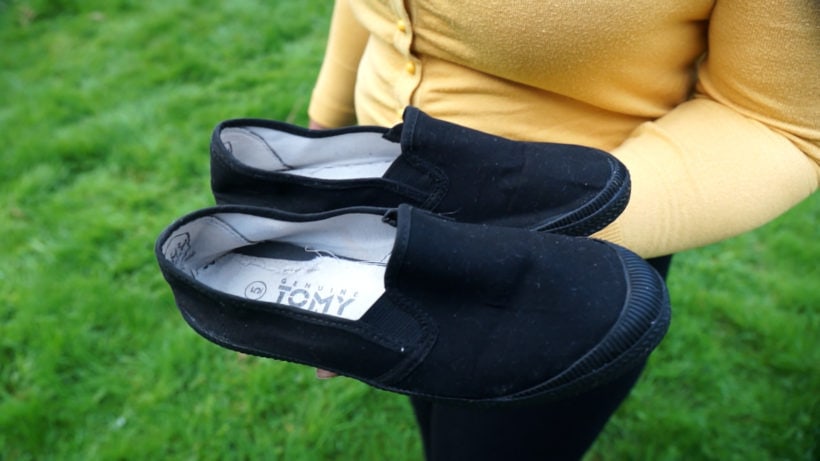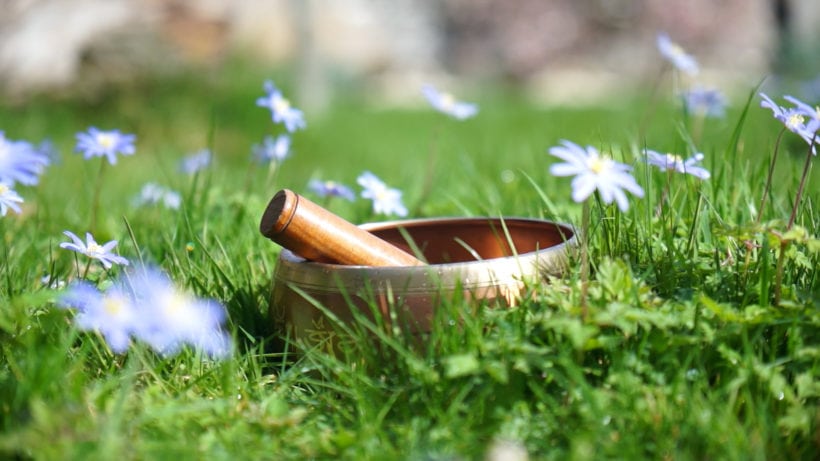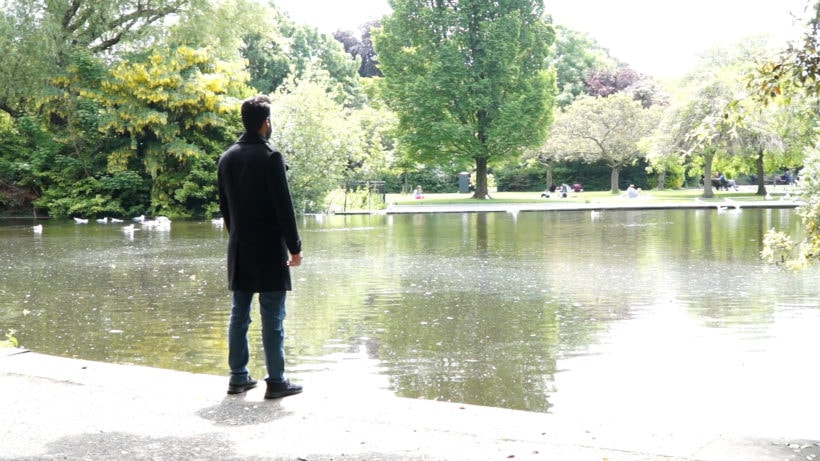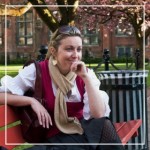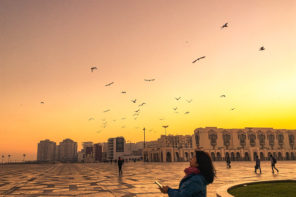I am going to start with breathing what I push out of me and what you push out of you and what we push out of each other
lungs working like billows
lungs working
sounds you could read on
the air is angry now
The air is thick with solidarity by Essa May Ranapiri
A bloodstained Nicaraguan flag, a jacket full of memories, necklaces that are rarely taken off- gifted by family members, shoes that dance, a Tibetan sound bowl that brings peace and healing – all feature in our DCU Irish Refugee Integration Network short film. It is recommended that you watch the film now, before reading on.
Ordinary Treasures: Objects from Home is underpinned by a commitment to what Roseann Liu and Savannah Shange (2018: 190) call “thick solidarity” – a form of solidarity anchored in the cultivation of radical empathy with the intimacies of experiences and lives which are not wholly accessible to one another. The film, through co-design and collaboration, follows educational philosopher Maxine Greene’s (1977) concept of “wide awakeness” which strives to encourage others to find conscious and intentional ways to “live deliberately” (1977: 120) through elevation, understanding, and empathy. We believe that this short film, as a kind of socially motivated artistic endeavour, with its’ emphasis on voice, object, story and music, can function as a multi-layered pedagogical tool.
The film participants (with the exception of one) chose not to be identified, as such, the visuals mainly focus on the storied artefacts. As a non-hierarchical, co-created film, the participants experimented with their voices and stories to articulate a shared humanity and desired social connections through meaningful objects. These storied objects serve as anti-racist method – a hopeful one that works in the service of enacting and producing thick solidarity. Becoming wide awake in this way is critical at a time when the “bright unbearable reality” (Badkhen 2022) of increasing conflict, displacement and the climate crisis is responsible for many kinds of uncertainties and fears – a time when we need collectivities of care more than ever before.
As academics writing from an Irish context, we see the need to centre the generation of thick solidarity in our work and engagement as an urgent ethical responsibility. For us, teaching otherwise, researching otherwise, writing otherwise and collaborating otherwise are engagements which form the bedrock of this thick solidarity. We have witnessed with alarm and sorrow the growth of a far right politics in Ireland that is actively pushing an anti-immigration agenda with similar tactics to those deployed elsewhere in Europe and North America, in what sociologists Ulrike M. Vieten and Scott Pontying (2023) call the ‘normalisation of the global far right.’ This comes at a point of multiple intersecting crises, where asylum seeker and international protection applicant numbers have increased and a lack of available housing has seen the widespread use of hotels and warehouses to temporarily accommodate those seeking protection.[1] More broadly, the Irish State has failed to meet reception standards generally and has not delivered on its commitment to abolish part of the Irish asylum system (an egregious system of institutionalised living) called direct provision (see especially Day 2020) which has been widely condemned (Hewson 2022).
In response to this current context, the DCU Irish Refugee Integration Network was established in May 2022. This initiative has been delivering English language classes and intercultural workshops since its inception, from Monday to Wednesday, at three different levels. It is volunteer-led by DCU staff and students from across the university. A curriculum attentive to the particular learning needs of forcibly displaced students has also been developed with further plans afoot to make this open access. These classes have created a small space of sanctuary for students and staff alike, bringing much needed joy, laughter and learning in a classroom that is whole person centred (Brantmeier and McKenna, 2020). For the staff involved, this has been about doing crucial meaningful solidarity work through pedagogy. In cultivating new socialities and spaces of affectivity, the DCU IRIN classroom has generated a place of learning and mutual social support which works against the false solidarity (one that creates hierarchies and maintains a particular status quo), which according to Ruslana Koziienko (2023), so widely exists in the context of forced displacement. Ordinary Treasures: Objects from Home, our short film which centres on the objects of forced displacement, emerged from this ethos of a collaborative classroom anchored in an ethics of care.
Understanding the material culture of forced displacement, of the power of mundane, familiar or intimate things to inspire empathy and solidarity is an important area of scholarly and creative interest (Yi-Neumann et al. 2023:15). Much of this work strives to engage the objects of forced displacement in both their socio-political contexts and deep affective dimensions. Our short film sits at this intersection of “shifting the focus from ‘identity-talk’ to ‘object-talk’ in order to better understand the complexity of migrants’ lives” (Yi-Neumann et al. 2023:15). There is a curious potency in the power of a storied object to inspire empathy and solidarity. In exposing intimacies and interiorities, objects produce their own creative alchemy, sometimes inexplicable. In Ordinary Treasures: Objects from Home, the selected objects serve as dossiers, as memory portals, and as tokens of interconnectedness. Through plotting the affective dimensions of the displacement journey, these objects also do anti-racist and solidarity work-conveying the complexities of displacement/post-displacement with clear and direct “no bullshit poeticism” (Chavez 2021).
The air is angry now: the path to co-design
“When you learn, teach; when you get, give.”—Maya Angelou
Swaying, swaying back and forth, back and forth, a blood stained Nicaraguan flag tells a story of protest, of solidarity but also of loss-of family and home left behind and of citizenship revoked. Swaying, swaying back and forth, back and forth, this flag betokens the complex configurations of lives lived through loss and forced displacement. The owner of the flag is firm in what she wants to convey and in what she seeks through the sharing of her story: radical understanding, empathy and solidarity. She, alongside other students in the DCU IRIN classes, were presented with the guiding premise of the film and invited to participate if they so wished. Students were immensely enthusiastic, particularly as many of them are housed in different kinds of asylum accommodation, some of which have witnessed far right protests.
Our objective with the film, co-produced in conversation with participating students, was to use the project to speak to spaces of encounter and humanity in the hope of cultivating empathy and solidarity. The film centres a version of Jean Paul Lederach’s (2005) vision of the moral imagination. As such, our aspiration is for the viewer to better imagine being part of a nuanced web of relationships, emphasising interconnectedness, solidarity and an ethics of care. Through the poesis of object, voice, story and music, the film project aspires to play a small role in generating an anti-racist community spirit and collective action at a time when it is crucially needed in an Irish context.
Embedded in our visual approach within the film is a sentiment akin to Tina Campt (2017), whose work is a poetic call to listen to images as something more than rhetorical in the way we approach them. Campts’ calls to push beyond the limits of what we are told and what we see into the sonic and haptic layers of the visual record resonates with how we approach our constellation of object, image, and sound in this short film. The storied objects gathered together in the film provide a lens onto resistances—both ordinary and extraordinary—so as to generate, where possible, affective dialogue and exchange. Our pathway to all of this is firmly situated within the spirit of co-design, one which we believe is necessary for the cultivation of a thick solidarity which, “can withstand the tension of critique, the pulling back and forth between that which we owe and that which we share” (Liu and Shange 2018: 196). Indeed, in this messy intersubjective ‘co-designed,’ space between ‘owing and sharing,’ we found creativity, imagination, re-imagination, laughter, care, embodiment and of course, empathy for each other’s experiences.
In preparation for the film, participants were asked to write a short reflection on an object that they had brought from home with them. Stories were workshopped in a class session, particularly as language levels slightly varied. Subsequently, with the support of a script-writer, Orla Bourke, participants engaged in individual discussions about how they wanted their stories articulated. Initial recordings were made with both the scriptwriter and participating DCU IRIN staff. Once the final versions of the stories were agreed by the participants, the DCU recording studio was used for individual recordings. For many of the participants, it was their first time in a recording studio so ensuring their comfort and sense of safety was paramount. The studio technician worked closely with Maria Loftus for the series of recordings in a trauma informed, sensitive manner, particularly necessary given the harrowing nature of some of the stories. The film directors followed up with participants across the subsequent days to ensure everyone’s ongoing well-being.
Next, we engaged participants in a co-design workshop, to storyboard and imagine the structure and flow of the short film. It also sought to ensure all participants were happy with how their stories were being represented, and comfortable with the accompanying imagery and soundscape. The cinematographer, Declan Nugent, a graduate of the DCU Master’s in Refugee Integration, also attended the co-design workshop. Discussions during that stage focused on participants’ decision to remain anonymous or to appear, partially or fully, in the film. The suggestion that the corporeal be put in relation to the objects was put forward with quite a few participants speaking about their comfort or discomfort with having their hands or blurred images of their physical selves on camera. Participants’ fears about being visible in the piece ranged from concerns about family members in the countries they had fled or indeed, concerns about one’s whereabouts being identifiable (particularly for those who had fled targeted gang or state violence). Others were concerned about possible impacts on their international protection applicant status
One of the most interesting elements of the co-design workshop was a discussion around how the storied objects would be emplaced within the Irish landscape. The workshop convenors came with an idea of juxtaposition and parallelism – that the journeys, objects, partial aspects of the participants stories could be put into visual conversation with sites of memory, history and conscience in Ireland – such as Magdalene laundries and industrial schools, famine sites, places of erstwhile conflicts and emigration ports. The convenors explained how they felt such parallelism might engender understanding and thus empathy – that in the betwixt and the between of different kinds of histories – there are shared experiences. The film participants firmly rejected this idea. Indeed, while they sought juxtaposition, it was not with places of loss or conflict, but with places of joy – beaches, parks, the buzzy Dublin cityscape. Their vision, which they agreed on collectively, was for a film that expressed their arrival in Ireland as a hopeful one. They were resolute in their determination to see their stay in Ireland, regardless of its length, as a positive, new chapter, in spite of the challenging reception conditions and international protection application process in which they find themselves.
Honouring the participants’ vision for this short film project was key to its co-creation. The cinematographer accompanied by DCU IRIN staff and participants filmed the objects in isolation and then with the participants, always sensitively following their guidance around how they wanted the filming to happen. Dublin location shoots happened independently with the cinematographer travelling to film the different locations. As with any creative endeavour, edits and transformation, although limited by a short-timeframe and small budget, were core to the final outcome. Later editions saw some participants asking for imagery of their home countries to be included to better balance the different juxtapositions, and some actively chose the accompanying scenes. The centring of a co-design process has thus been a learning journey for all involved. However, crucially as an endeavour anchored in attentive listening, sharing and exchange, collaboration and an ethics of care, its outcome has been one attuned to the creative wishes and desires of all participants.
In many ways, this is a film that brings—through storied objects—a bearing witness to the nuance and complexities of forced displacement departures and arrivals. Swaying, swaying back and forth, back and forth, in different parts of the film are two necklaces, both owned by women who have experienced extreme violence in their lives. The necklaces come from two countries: their owners very different. Both of their stories, however, beckon towards the urgent need for remedy, recovery and repair in responses to forced displacement. In so doing, these storied objects (like the others in the film) render visible the intersecting constellations of universalism in loss and survival as it manifests in complex life configurations and the displacement journey.
Sounds you could read on: the making of a musical score
Normally, we don’t pay any attention to the … rising and falling of our voices as we toss our thoughts back and forth to each other. We just talk and listen. The only time we pay attention to these qualities is in song.
Spearin, The Happiness Project.
The owner of the shoes that dance sings in this short film. She has sung many times for us now. The first time her voice quivered, she wanted to evoke the magnitude of emotion she felt for the loss of her family and home. She gets braver, her voice stronger and we re-record. Her voice sits into the flow of the musical score as it does with the simple, pure tone of the Tibetan sound bowl, filling the aural space. The bowl and the singing, the only two explicitly musical samples, are serendipitously both in C-Sharp, a distant key to the rest.
The original score uses elements derived from the voice samples to support the testimonies, using the inherent creativity in vocal expression as a guide for the music. Pitch (tone height), timbre (quality of the voice) and tempo (speed of articulation) are the main musical elements of voice prosody, the expressive qualities of voice. The composer sought to create harmony between the testimonies, created from the centre pitches of the speakers, thus striving to highlight common experience in the piece. The rate of speech is used to inform the tempo of the music over each speaker.
To achieve this, pitch tracking and segmentation was performed on the voice samples, extracting the melody of the speech. Despite the fact that several of the participants are not speaking in their native language, the non-explicit expression in their voice can be heard and celebrated. This was followed by key analysis for the harmony and event rate estimation for tempo. In using these features, the music supports the voice and the voice informs the music. The film’s musical score thus works in communion with our participants’ voices but also their losses, their hopes and their dreams. Note, pitch, melody all aspiring to trace, map and inspire empathy thereby fashioning a form of melodic thick solidarity.
The air is thick with solidarity: concluding reflections
“Don’t ask what the world needs. Ask what makes you come alive, and go do it. Because what the world needs is people who have come alive”
The owner of the jacket walks through a well-known Dublin park. He wants us to understand the textures of the worlds that are interwoven in his jacket. His story evokes interconnection, resolve, memory, comfort and repair but at the same time, indeterminacy, contingency and losses of many kinds. His jacket will eventually grow old and be replaced. He imagines this and so too his unfolding commitment to a new life in Ireland. As the owner of the jacket walks through the Dublin cityscape with ease, he shows viewers how in the movement between displacement and emplacement there are so many “unspoken relations” (Campt 2017). Our short film aspires to do this too, while it cannot be a remedy in full, it can through its attunements with the power of listening to the storied objects of forced displacement begin to play a role in generating thick solidarity. For us, as members of the DCU IRIN collective, this short film is part of an ongoing journey to cultivate anti-racism in the spaces we work and live in. This kind of way-making in teaching and learning, choreographed as antiracist and decolonial, is now an imperative. For the participants in the film, the method of co-design was wholly agentive.
On June 20th 2023, World Refugee Day, we held a launch for the short film in Dublin City University and many of the film’s participants attended. Some wept openly, and some spoke of how their displacements shot through with the wounds of loss, longing but also resistance were made visible through this intentional and evocative bricolage of object, voice and story. In spite of the ongoing traumas of their displacement journeys, for many of the participants, co-designing the short film became a source of joy – a scaffold between struggle, loss, ethical deficit and a chance to retell, to own and to begin again. Through co-design and collaboration, together with the participants, we sifted through and animated objects of displacement. Together, we found the kind of wide-awakeness which Stephanie Bartlett (2022) tells us has the possibility to be an antidote for complacency and grief. The cultivation of this collective wide-awakeness through co-design and collaboration is now a key foundation for the future work we plan to develop with the film participants and others over the coming months and years.
This short film thus joins Wenders and Zournazi’s (2013: 107)‘creative revolt to change perceptual habits’ so as to disrupt and thus facilitate reimagination – a mundus imaginalis (Corbin 1976) in the making. In so doing, we see it as making a small contribution to relations of thick solidarity in displacement work. Indeed, in our uncertain world, as academics who work with those who have been forcibly displaced, our responsibilities thus lie first and foremost in this space of thick solidarity-deliberately grounded in ethics, integrity and radical care. This is the only way forward now for many of us doing this kind of work.
References
Badkhen, A. 2022. Bright Unbearable Reality. New York: New York Review of Books.
Bartlett, S. 2022. “wide-awakeness as an antidote for…” in JCACS Musings Publication. https://medium.com/jcacs-musings/wide-awakeness-as-an-antidote-for-420bbbfd1e00 (accessed August 15th, 2023).
Brantmeier, E.J. and McKenna, M.K. eds., 2020. Pedagogy of vulnerability. IAP.
Campt, T.M., 2017. Listening to images. Duke University Press.
Chavez, F.R., 2021. The anti-racist writing workshop: How to decolonize the creative classroom. Haymarket Books.
Corbin, H. and Horine, R., 1976. Mundus imaginalis, or, the imaginary and the imaginal. Ipswich: Golgonooza Press.
Green, M., 1973. The teacher as stranger. Belmont, CA: Wadsworth.
Hewson, D., 2022. ‘All the time watched’: an analysis of disciplinary power within the Irish Direct Provision system. Journal of Ethnic and Migration Studies, 48(3), pp.676-692.
Koziienko, Ruslana. March 2023. ‘Against false solidarity. A call for true solidarity among people with experiences of displacement.’. Allegra Lab. https://allegralaboratory.net/against-false-solidarity-a-call-for-true-solidarity-among-people-with-experiences-of-displacement/ (accessed June 12th 2023).
Lederach, John Paul. The Moral Imagination: The Art and Soul of Building Peace. Oxford, MA: Oxford University Press, 2005.
Liu, R. and Shange, S., 2018. Toward thick solidarity: Theorizing empathy in social justice movements. Radical History Review, 2018(131), pp.189-198.
Coakley, L. and MacEinri, P., 2022. Ireland’s White Paper to End Direct Provision (2021): Migrant Accommodation and Control. International Migration Review, 56(4), pp.1030-1039.
Wenders, W. and Zournazi, M., 2013. Inventing Peace: A dialogue on perception. Bloomsbury Publishing.
Vieten, U.M. and Poynting, S., 2022. Normalization of the Global Far Right: Pandemic Disruption?. Emerald Group Publishing.
Yi-Neumann, F., Lauser, A., Fuhse, A. and Bräunlein, P.J., 2022. Material Culture and (Forced) Migration: Materializing the Transient. UCL Press.




